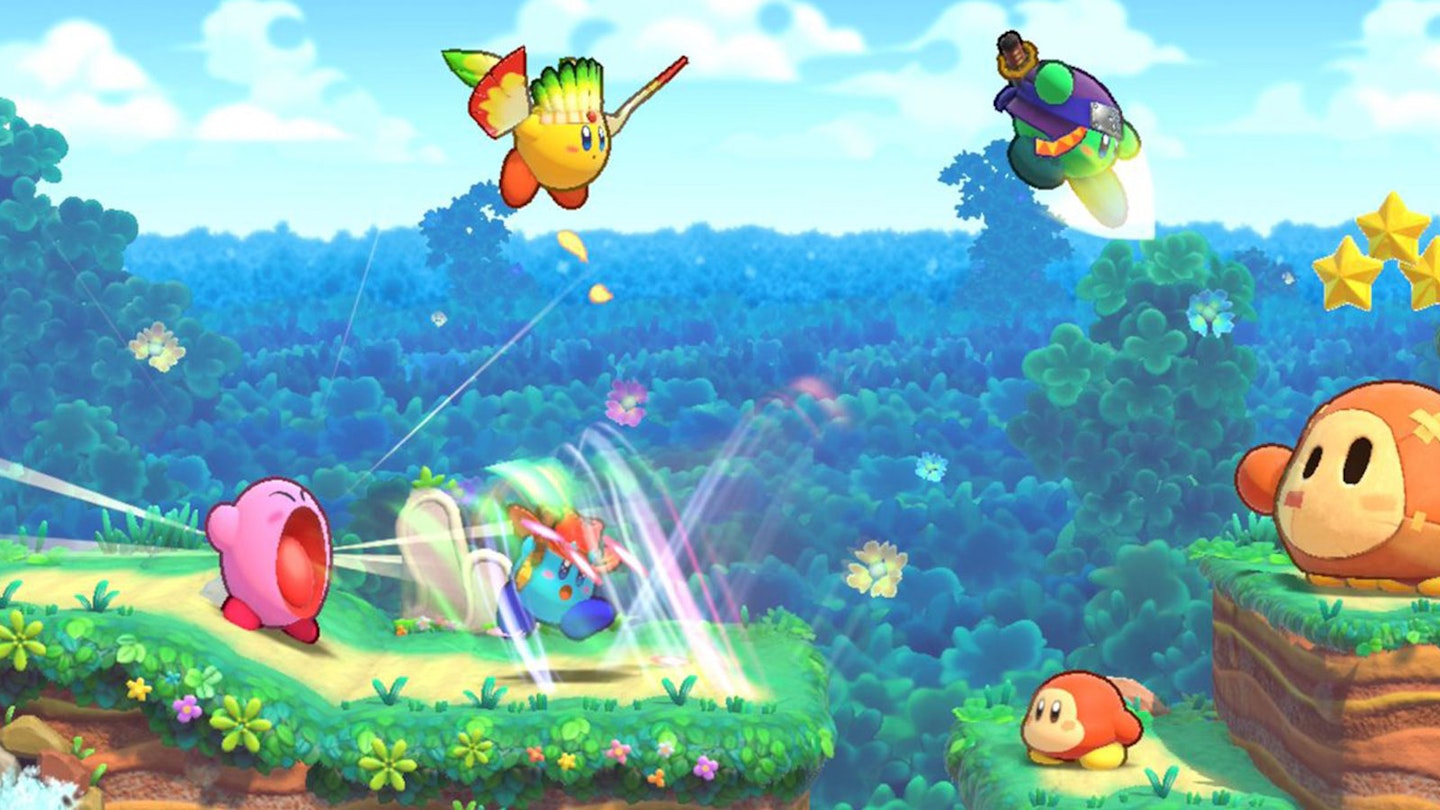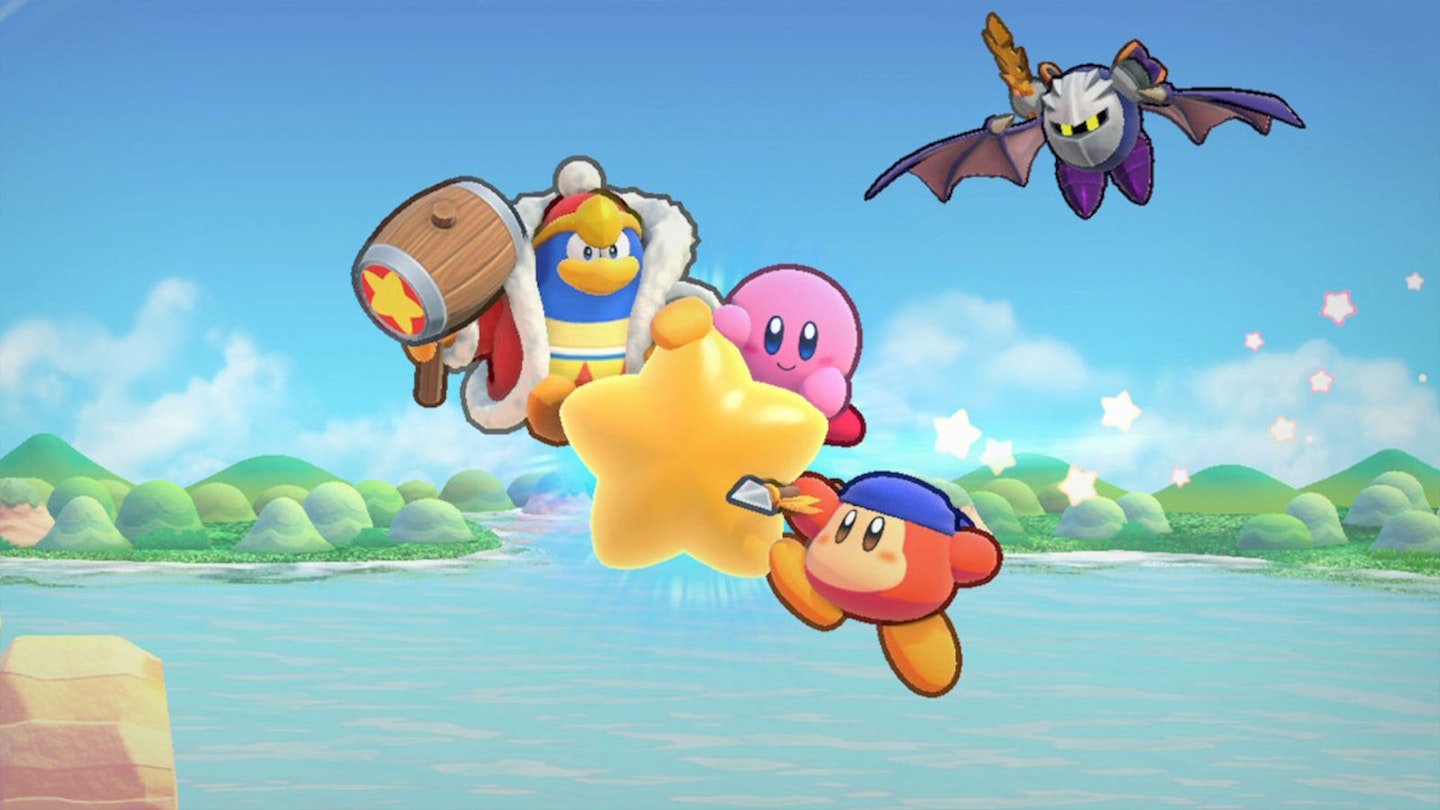Platforms: Nintendo Switch
It’s the return of the return of Nintendo’s inflatable superstar in this remaster of 2011’s classic platformer. Originally known as Kirby’s Adventure Wii in Europe, Return To Dream Land is a slightly unexpected choice for Nintendo to update for the Switch. The majority of first party ports to the home-handheld hybrid have been Wii U games, giving great but overlooked titles a chance to find a wider audience. Given that pattern, one might expect 2015’s Kirby And The Rainbow Paintbrush to have been a more likely candidate for a next-gen glow-up rather than this popular Wii title, but since the series stepped into full 3D mechanics with last year’s Kirby And The Forgotten Land, it’s perhaps Return to Dream Land’s focus on classic Kirby gameplay that earmarked it for revival.
That’s because, at its heart, Return To Dream Land is a distillation of everything great about the long-running series: bright, cheery, stress-free platformers with effectively zero threat, but packed with clever puzzles, fun combat abilities to experiment with, and oodles of charm. That’s as true in Deluxe as it was in the original version, with everyone’s favourite blob of power-stealing bubblegum (our best guess for what Kirby actually is) helping the stranded Magolor reclaim the pieces of his broken starship in order to return home. Cue hopping around the five corners of Planet Popstar, using Kirby’s ability to float and hoover up everything in his path on the way to gathering dozens of power gears and key ship parts.

As ever with a Kirby game, don’t expect much of a challenge. This is a colourful, simple platforming affair, with the trickiest obstacle most players are likely to face being occasionally missing one of the better-hidden collectibles scattered through each level, requiring you to play through again in order to find it. Even in the later sections of the game, you’re more likely to lose Kirby a life through player error — tumbling down a crevice or squishing him in a mis-timed dash through closing walls, for instance — than you are being overpowered by enemies or even bosses. You can further mitigate against even those meagre complications by activating the ‘Helper Magolor’ feature, which sees the newcomer prevent Kirby from falling down gaps, or providing health if you get low.
It’s still a simple and mostly unchallenging experience, but it provides just enough of a step up in difficulty over the base game to appeal to older players.
The flip side, of course, is that while this incredibly low difficulty level makes Return To Dream Land Deluxe best suited to new or younger players – who the entire franchise is aimed at, to be fair – it also makes for a relaxing gaming session for more seasoned ones. Happily making your way through each of Dream Land’s levels is a shortcut to serotonin, punctuated with deliberately, delightfully overpowered moments where Kirby gains a super ability – upgraded versions of some of his signature moves, such as Ultra Sword – and sears his way through stages like an unstoppable force of nature.
For the core game, the remaster treatment doesn’t add much. The visuals get a nice enough boost, but the animated aesthetic of the Wii original never really needed much of an overhaul. Instead, developer HAL Laboratory has tweaked and refined a few areas. Kirby can gain two new Copy Abilities from swallowing — Mecha, turning him into an adorable miniature Iron Man-meets-Gundam orb, and Sand, allowing him to whip up sandstorms — with both having new dedicated challenges to beat between levels. Movement gets a slight update too, with Kirby now able to dodge and, when floating, air dodge, making everything feel a touch speedier and smoother. By and large though, this is very much a repackaging of the Wii game, simply updated for the times.

However, there’s a lot more to Dream Land Deluxe than just the core game. Firstly, there’s a brand new story mode, Magolor Epilogue. Unlocked after completing the main story, this is essentially a whole new game. Here, players control Magolor himself, gathering magical energy to restore his mystical abilities. Levels can be played on repeat, building up magic points to spend on upgrading abilities. If Kirby titles are “my first platformer” games, then Magolor Epilogue is “my first roguelike”, stripping that genre’s play/die/repeat format right back to a much friendlier play/collect/repeat. It’s still a simple and mostly unchallenging experience, but it provides just enough of a step up in difficulty over the base game to appeal to older players, while a ranking feature scoring you on time to complete each level will tempt you back over and over until you ace each one.
Then there’s the introduction of Merry Magoland, a theme park with just over a dozen mini-games to partake in. Think of it as a compact Mario Party, with each of the rapid-fire games playable by up to four players, but less likely to ruin friendships. There’s a host of sometimes weird but always fun challenges, such as Crackity Hack, where you have to charge energy and aim a perfectly timed punch to try and punch clean through the planet, or the aptly named Egg Catcher, where a robot rapidly lobs eggs and bombs at Kirby, who has to gobble the former and dodge the latter. These can all be played individually or tackled in blocks of four through the ‘Magoland Tour’.
However, the big draw is meant to be Samurai Kirby, a test of reflexes where two players face off in a sword fight scene ripped straight from samurai cinema, drawing their blade and striking their opponent down in a single blow. It’s lightning fast, with draw speed measured in milliseconds, and Nintendo seems to think it’ll be popular enough to warrant a dedicated online ranking mode, Samurai Kirby 100. It’s definitely a nice addition, but given the mode is so incredibly brief, it does seem unlikely that there’ll be much sustained competition there.
It’s these multiplayer elements, both in the Magoland mini-games and with the ability to play the main Return to Dream Land adventure with friends, that give Deluxe much greater replay appeal than it enjoyed in its original form. Long after you’ve restored Magolor’s ship, or even after you’ve completed his epilogue campaign, players are likely to turn to the game for a few fun, low-stakes party games. The main game may be easier than ever, but the side content remains endlessly fun whatever your age or skill level.
